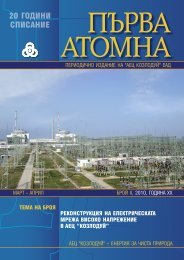Summary Report for Conduct of Kozloduy NPP Stress Tests
Summary Report for Conduct of Kozloduy NPP Stress Tests
Summary Report for Conduct of Kozloduy NPP Stress Tests
Create successful ePaper yourself
Turn your PDF publications into a flip-book with our unique Google optimized e-Paper software.
“<strong>Kozloduy</strong> <strong>NPP</strong>” PLC<br />
SUMMARY REPORT<br />
<strong>for</strong> <strong>Conduct</strong> <strong>of</strong> <strong>Kozloduy</strong> <strong>NPP</strong><br />
<strong>Stress</strong> <strong>Tests</strong><br />
Threshold effect on the progress <strong>of</strong> the process is provided by discharge <strong>of</strong> the accumulator<br />
batteries (after about 10 hours). After that the operator does not dispose in<strong>for</strong>mation on unit<br />
parameters and shall per<strong>for</strong>m accident management actions blindly.<br />
If an event occurs at power operations or in cold condition with pressurized primary circuit,<br />
threshold effect is provided by exhaust <strong>of</strong> water reserve in the tanks <strong>of</strong> SG emergency make-up<br />
system. In the first case this effect is expected after about 28 hours, and in the second case – after 50<br />
hours.<br />
In case <strong>of</strong> depressurized reactor the threshold is start <strong>of</strong> core heating up which occurs<br />
relatively early – after less than 2 hours. During this period the operator shall prepare and start<br />
drainage <strong>of</strong> the hydro accumulators (preferable first to the cold part <strong>of</strong> the reactor). Drainage <strong>of</strong> the<br />
three hydro accumulators delays start <strong>of</strong> core heatup <strong>for</strong> 4 hours.<br />
5.1.1.4 Loss <strong>of</strong> <strong>of</strong>f-site power supply, emergency diesel-generators, additional dieselgenerator<br />
and mobile diesel-generator<br />
5.1.1.4.1 Capacity <strong>of</strong> the batteries, operational time period and capabilities to recharge them in<br />
this situation<br />
See par. 5.1.1.2.2.<br />
5.1.1.4.2 Actions envisioned to provide mobile on-site or <strong>of</strong>f-site power supply sources<br />
See par.5.1.1.2.2.<br />
5.1.1.4.3 Time period required providing alternate current power supply and restoration <strong>of</strong> core<br />
cooling be<strong>for</strong>e fuel damage occurs. Threshold values in plant behaviour<br />
Assessments were per<strong>for</strong>med <strong>for</strong> conditions <strong>of</strong> the units, described in section <strong>of</strong> Ch.15<br />
[7],[8]. For each <strong>of</strong> the modes operator actions considered in the analyses, are specified, as aimed at<br />
prolongation <strong>of</strong> time period be<strong>for</strong>e fuel damage occurs.<br />
Table 5.1-3: Assessment <strong>of</strong> time period to fuel damage at loss <strong>of</strong> normal and standby power<br />
supply, failure to all emergency DGs, failure to additional DG, failure to mobile DG.<br />
Time to fuel<br />
Option<br />
damage<br />
(h:min)<br />
1 Power operations<br />
(Considered: passive make-up <strong>of</strong> SG from the high pressure<br />
deaerator)<br />
2 Shut down reactor, planned cooldown at pressurized primary<br />
circuit and drained SG<br />
(Considered: drainage <strong>of</strong> ECCS three hydro accumulators.)<br />
3 Shut down reactor, planned cooldown at pressurized primary<br />
circuit and non-drained SG<br />
(Considered: drainage <strong>of</strong> ECCS three hydro accumulators.)<br />
16:15<br />
16:44<br />
19:44<br />
145/202

















